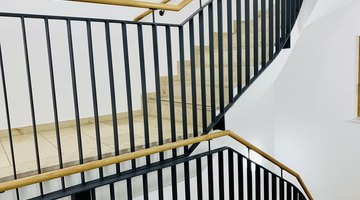Minnesota Standards for Stairway Handrail Height
Table of Contents
If you're adding four or more stairs to a new room in your home, you'll need to abide by Minnesota handrail height standards. These requirements are created for safety reasons. The handrail standards are public information and can easily be found before you begin your build.

If you have any experience at all in construction or home renovations, you know that you can’t just start building without a comprehensive knowledge of building codes for your area. In Minnesota, this means abiding by at least the state’s building codes and possibly your jurisdiction’s stricter codes.
Before you install a stairway handrail, remember to look up the required minimum and maximum heights from the top of the nose of the stair.
Tip
In Minnesota, handrails must be a minimum of 34 inches and a maximum of 38 inches from the nose of the stair or the slope of the tread. However, your state or jurisdiction may require even more specific heights.
Minnesota Residential Code Regarding Handrails
So you paid your fees, got your permits, and finally built that new addition to your home. Whether it’s a new den area for your family or a screened-in porch, before you can finish your project, you must make sure that you’ve followed Minnesota handrail codes.
At the very least, this means that stairways with four or more risers are required to have a handrail. A riser is the vertical part of a stair, so you can read this as any staircase with four or more stairs. That handrail must then be between 34 and 38 inches when measured vertically from the lip of the stair or 34 to 38 inches when measured vertically from the tread of the slope.
Minnesota stairway handrail code makes clear that it doesn’t matter if your stairway leads to a deck, porch, sunroom, or garage. Stairs in a dwelling must abide by the code outlined in R311.7.1.1. However, there are two exceptions: Stairways leading to the attic and stairs that only function to access mechanical or electric equipment in your home need not follow the Minnesota handrail code.
Local Handrail Height Requirements
The Minnesota Building Codes are created as a minimum safety requirement to protect life and limb from dangerous construction designs. However, they change every six years, so you’ll have to make sure to keep checking back if you continue to work on your home in the future.
On top of the changing state building codes, local jurisdictions can create their own enforceable building codes that differ from the state level. For example, Minneapolis, Minnesota, requires that handrails be built 30 to 34 inches above the nose of the stair when measured vertically. Meanwhile, St. Paul, Minnesota, has simply adopted the state guidelines of stairway handrail height between 34 and 38 inches.
You can find your local jurisdiction building codes in Minnesota by searching the Minnesota State Building Code Jurisdiction Directory.
Other Handrail Requirements
When planning the construction design of your stairway, it’s not just handrail height that you’ll have to consider. Minnesota also requires that handrails shouldn't jut out from the wall more than 4 1/2 inches on either side. The handrails must not obstruct at least 31 1/2 inches of stairway if there's a single handrail and 27 inches if handrails are bookending both sides of the stairway.
Again, just as you would with the handrail height requirements, make sure to look up your jurisdiction to see if your local area's building codes differ from the state building codes. Once you have confidence in your code requirements, you can safely begin your build.
References
- City of Saint Paul: Stairways and Handrails for Residential Structures
- Minnesota Department of Labor and Industry: Porches and the 2020 Minnesota Residential Code
- Minnesota Legislature: Office of the Revisor of Statutes: Minnesota Administrative Rules
- Minneapolis Code of Ordinances: 244.550. Stairways and Porches.
- Minnesota Department of Labor and Industry: Overview of the Minnesota State Building Code
- Minnesota Department of Labor and Industry: Local Code Lookup: Minnesota State Building Code Jurisdiction Directory
More Articles



